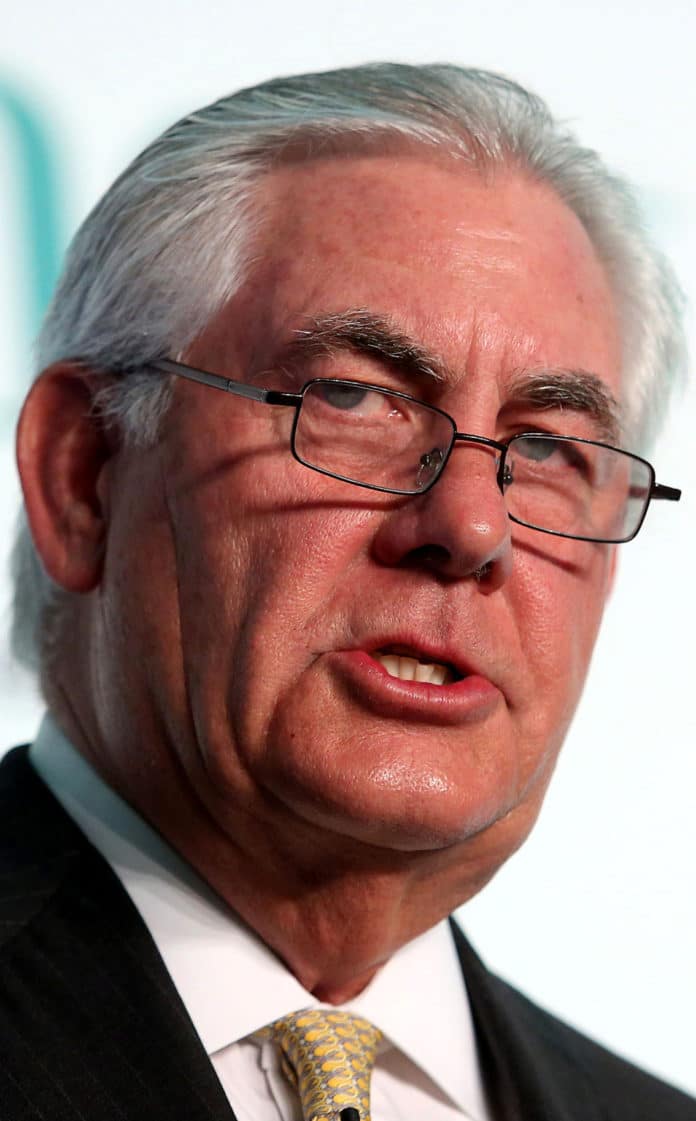Exxon Mobil Corp. is cutting its drilling budget to a 10-year low and halting share buybacks after last year’s belt-tightening failed to shield the world’s biggest oil explorer from crashing energy markets.
On the heels of its smallest annual profit since 2002, Exxon said it’s curbing its spending on rig leases, floating oil platforms, gas terminals and other projects by 25 percent this year to $23.2 billion, according to a statement on Tuesday. That represents the leanest spending plan since 2007, the second year on the job for Chairman and Chief Executive Officer Rex Tillerson. Share buybacks that cost the Irving, Texas-based company half a billion dollars during the final three months of 2015 also have been suspended.
Tillerson, who reaches Exxon’s mandatory retirement age of 65 in 13 months, has been reducing spending since before the crude-market collapse that began in mid 2014 as the company’s costliest mega-projects were completed. Capital outlays that peaked at $42.5 billion in 2013 have been reduced by 45 percent, according to data compiled by Bloomberg. All of Exxon’s rival super-major oil producers that have disclosed results so far have been bleeding red ink.
“They are actually executing pretty well,” Sam Margolin, an analyst at Cowen and Company in New York, said in an interview after the results were released. “It’s typical Exxon.”
The oil-market rout has wiped out $764 billion in market value for international explorers in the past year. Even global standouts like Royal Dutch Shell haven’t been insulated from the pain: the Anglo-Dutch giant’s credit rating was cut on Monday to the lowest-ever by Standard & Poor’s. Chevron said last week that it’s bracing for a credit review as well, and BP earlier Tuesday said it suffered a record $6.5 billion annual loss last year.
For Exxon, full-year net income fell by more than half to $16.2 billion in 2015, the lowest since 2002. Fourth-quarter net income fell to $2.78 billion, or 67 cents a share, from $6.57 billion, or $1.56, a year earlier, The per-share result was 4 cents higher than the average profit estimate of 19 analysts in a Bloomberg survey.
Exxon is the only super-major oil company so far to report better-than-expected fourth-quarter results amid the worst energy market downturn in a generation. Shell warned investors last month that fourth-quarter profit probably fell by 42 percent. Chevron, the biggest global producer by market value after Exxon, posted its first quarterly loss since 2002 on Jan. 29. The dismal results reflected oil’s 41 percent plunge in the past 12 months.
Last year, Exxon shrank spending on drilling, floating platforms and gas-export terminals by 20 percent to $31 billion, a bigger cut than the 12 percent reduction forecast by management during the company’s annual strategy presentation in March. During the first eight years of the Tillerson era at Exxon that began in 2006, capital spending more than doubled.
In December, Exxon’s board promoted refining boss Darren Woods to the position of president, signaling he’s in line to succeed Tillerson.
A $538 million fourth-quarter loss in the company’s U.S. oil and gas business was cushioned by a near doubling in profit from Exxon’s refineries, according to the statement. Output from wells jumped 4.8 percent worldwide even as the company cut gas production throughout the Americas and Europe.
The benchmarks for international crude and U.S. gas both dropped 42 percent during the final three months of 2015 as global production continued to overwhelm demand. Oil traded near $30 a barrel Tuesday.
Brent crude futures averaged $44.69 a barrel during the fourth quarter, compared with $77.07 as year earlier, according to data compiled by Bloomberg. U.S. gas averaged $2.235 per million British thermal units during the period, down from $3.829 a year earlier. Oil and liquid byproducts comprise about 60 percent of output from Exxon’s wells; the rest is gas.
Worldwide oil demand growth probably will slow to 1.3 percent this year from a 1.9 percent rate of expansion in 2015, according to the International Energy Agency in Paris.
Exxon’s stock dropped by 16 percent last year for the worst annual performance since 1981. Shares fell 2.5 percent to $74.39 at 10:08 a.m. in New York.






